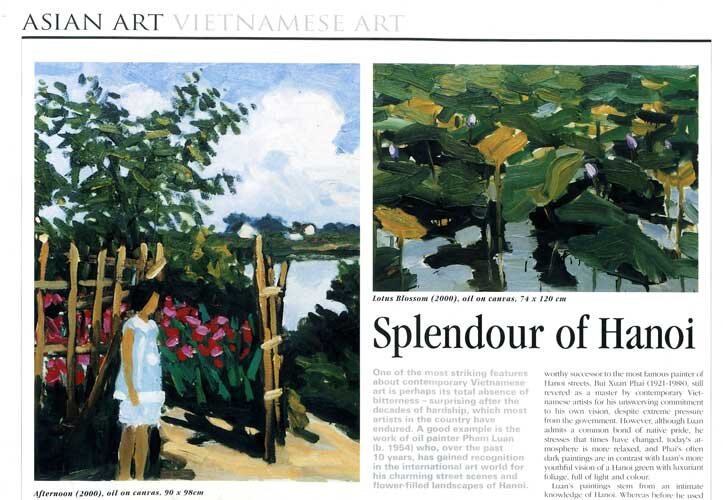Splendour of Hanoi
by Hilary Binks
One of the most striking features about contemporary Vietnamese art is perhaps its total absence of bitterness – surprising after the decades of hardship, which most artists in the country have endured. A good example is the work of oil painter Pham Luan (b. 1954) who, over the past 10 years, has gained recognition in the international art world for his charming street scenes and flower-filled landscapes of Hanoi.
Afternoon. 2000
Pham Luan’s third one-man show in Hong entitled Splendour of Hanoi, presented by Galerie la Vong last year, was evidence of a painting style which has evolved and matured since he was ‘discovered’ in the early 1990s. While his principal source of inspiration remains his beloved home city, Luan’s style is now less representational, freer and more confident, using stronger colours and broader brushstrokes to convey his emotions. “This year my feeling is very strong,” he says, “and my urge to paint overwhelming.”
Originally trained as a teacher, Luan is a self-taught artist, who followed a book of artistic instruction by the Vietnamese master Nguyen Van Ty, strongly influenced by the French classical style. Senior artists attended the Académie des Beaux-Arts de l’Indochine, founded in 1925 by Victor Tardieu, a friend of Henri Matisse. After the Second World War, the school reopened as the Hanoi College of Fine Arts. Such colonial links, together with the country’s isolation from the West for several decades, make Vietnamese art unique in Asia.
Luan greatly admires the French Impressionists, especially Claude Monet, which no doubt accounts for the crucial important of light and colour in his painting. He excels at depicting the beauty of dappled light on the ancient streets, old quarters, flower markets and garden scenes at different times of day and different seasons of the year.
“A painting will only come alive, will only succeed in drawing the viewer in, if the light is strong. A merely neutral light will fail to attract his attention. The quality of light defines the time of day, from the rosy of light defines the time of day, from the rosy light of dawn as the sun rises; to the harsher, bright light of noon; to the warm glow and lengthening shadows of late afternoon and approaching dusk.” he explains.
If Luan’s work is reminiscent of romantic European paintings, his inspiration is purely Vietnamese. Many observers have seen him as a worthy successor to the most famous painter of Hanoi streets, Bui Xuan Phai (1921-1988), still revered as a master by contemporary Vietnamese artists for his unswerving commitment to his own vision, despite extreme pressure from the government. However, although Luan admits a common bond of native pride, he stresses that times has changed, today’s atmosphere is more relaxed, and Phai’s often dark paintings are in contrast with Luan’s more youthful vision of a Hanoi green with luxuriant foliage, full of light and colour.
Luan’s paintings stem from an intimate knowledge of Hanoi. Whereas before he used to make rough sketches, nowadays this is no longer necessary as he can record a scene, especially the light, in his mind’s eye. “Houses, street corners, and rows of trees are commonplace. But all of a sudden they look curiously splendid in summer sunshine or radiant after an early thunder shower. All these things are stored in my memory.” He says.
Figures are an important part of Luan’s compositions, whether shopkeepers minding roadside stalls, or graceful young girls dressed in traditional white ao dai riding bicycles by a lake. In his most recent work, these figures are more often given prominence in the foreground, rather than being part of the general landscape. “I think this is because I have gained greater confidence than previously,” says Luan. “I feel I have achieved a good technical mastery of this medium, which gives me freedom to express my deepest feelings.”
This refined technique may also turn out to be Luan’s best defence against a string of young plagiarists of his work in Hanoi’s increasingly commercially-driven art scene. “The silver lining of this unfortunate development,” says Luan, “is that it pushes me to do even better work, so that I cannot be copied. I feel my technique is strong enough to remain above all this, to maintain my artistic integrity”.
Soft-spoken, with a warm smile, Luan paints alone in his studio and does not have much contact with other artists. Although he was brought up in a classical Vietnamese household, he readily admits that at heart he is a romantic. His aim is for all his work to be beautiful, positive, and optimistic; he has no wish to portray sadness or despair. “Any artistic work should imply the genuine emotion of its author. The heart, the mind and the hands of the artist must be in perfect harmony. Yet emotion alone is deficient without creativeness and hard work.”


